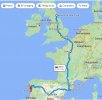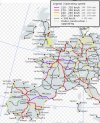It is possible, subject to my previous comments quoted by
@Kirkie above, that a direct flight London to SdC and a bus ride to Sarria will have a lower carbon cost than any other possible route or transport combination. Ferries, burning heavy fuel oil, are massive particulate generators. Rail network construction / maintenance has huge environmental impacts (and political
https://www.bbc.co.uk/news/world-europe-64717605 ) even though the trains run on renewable resourced electricity.
This is
not a poke at the OP though it is going to seem like one: If you want to go for a nice 100km walk in interesting countryside and with some sort of meaningful destination but minimise your carbon impact walk locally, walk where you live. In the UK walk Southwark to Canterbury, or Reading to Southampton, or the Cuckmere Pilgrims Trail.
If you want to make pilgrimage to the shrine of St James then do it but find ways of off-setting the carbon cost with everything you do with the rest of your life.



























